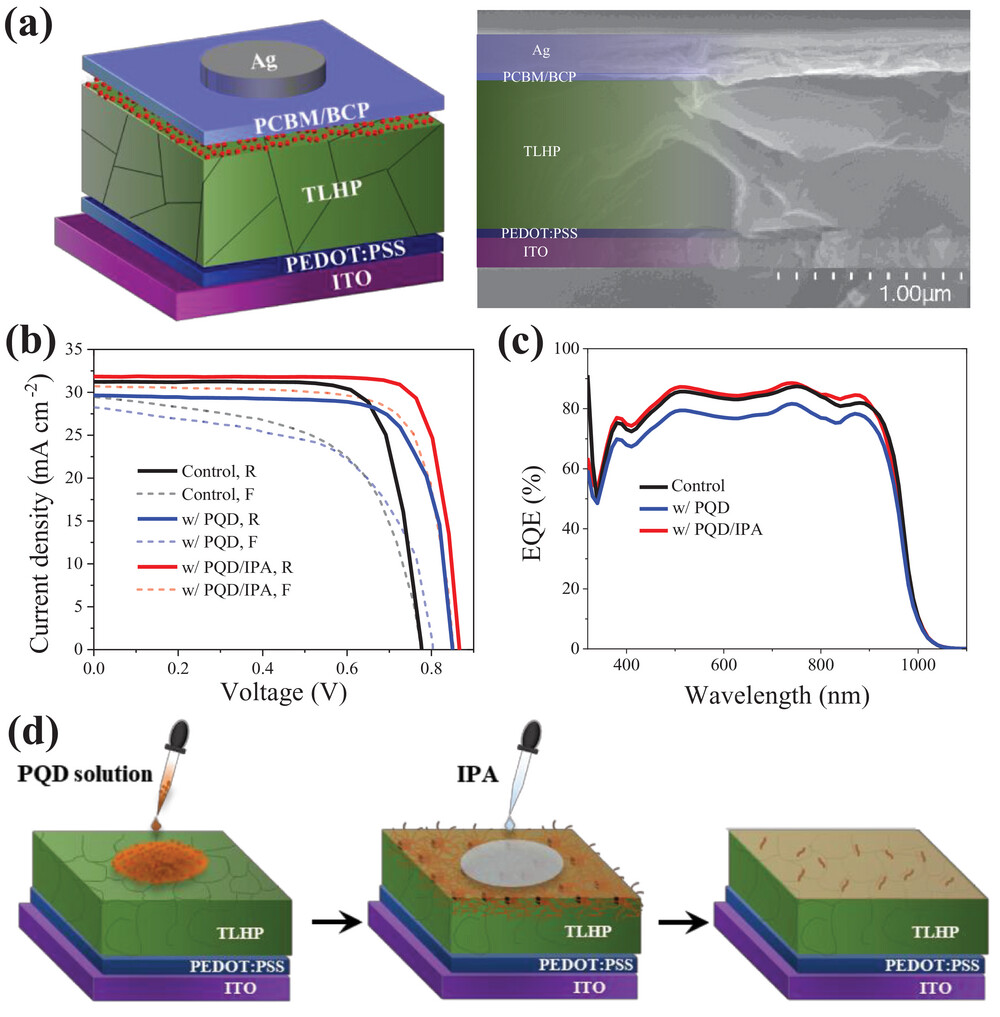A research team, led by Professor Sung-Yeon Jang from the School of Energy and Chemical Engineering at UNIST has achieved a remarkable advancement in solar cell technology. Collaborating with Professor Sang Kyu Kwak and his team at Korea University, the researchers have developed a pioneering technology that significantly boosts the efficiency of solar cell devices by integrating tin-lead halide perovskites (TLHPs) photoactive layers with quantum dot layers.
The key innovation lies in the creation of a thin film layer that bonds the combined materials, resulting in a substantial increase in battery efficiency. This bonding layer strengthens the internal electric field, reduces defects at the interface, and enhances the movement of electric charges, thereby improving charge extraction efficiency.

Figure 1. Modification of TLHP layers with FAPbI3-PQD and their effects on device performance: (a) Structure and cross-sectional SEM image of a TLHP-based device, (b) J–V characteristics of devices under AM 1.5G one-sun illumination, (c) EQE spectra, and (d) schematic illustration of the PQD modification on the TLHP active layer. Note: A thin layer of PQD was coated onto the TLHP film using an octane-based solution.
One of the challenges with tin-lead halide complexes is their limited energy gap between bands, despite their excellent light absorption capabilities in the near-infrared region. The presence of internal defects and short charge movement distances has hindered stable charge extraction in the past.
To address this issue, the research team coated perovskite quantum dots with a thin film over the tin-lead perovskite layer, effectively mitigating the chronic problem and improving stability.
By applying quantum dot material to the TLHP film surface, the researchers significantly reduced surface defects on the quantum dot, enhancing the stability of the thin film. Moreover, the alignment of energy levels and efficient collection of electric charges, enabled by the unique properties of the materials, now allow for enhanced electron extraction and increased extraction of electric charges generated by sunlight.
 Figure 2. Morphology, crystal structure, chemical compositions, and trap density of PQD-modified TLHP layers: (a–c) Top-view SEM images of TLHP layers: (a) neat, (b) with pristine PQD, and (c) with PQD/IPA.
Figure 2. Morphology, crystal structure, chemical compositions, and trap density of PQD-modified TLHP layers: (a–c) Top-view SEM images of TLHP layers: (a) neat, (b) with pristine PQD, and (c) with PQD/IPA.
The solar cell device, fabricated using this advanced technology achieved a record-breaking photoelectric conversion efficiency of 23.74% for TLHPs, marking a substantial improvement over existing methods—an increase of approximately 20%.
Professor Jang emphasized the significance of integrating quantum dot and perovskite solar cell technologies, highlighting the potential for high-efficiency solar cells in the future. This research breakthrough opens up new possibilities for the development of next-generation solar cells with enhanced performance and efficiency.
This study was conducted with the participation of Dr. Muhibullah Al Mubarok and Yu Jin Kim from the Combined MS/Ph.D. Program of Energy and Chemical Engineering at UNIST. Their findings were published in the online version of Advanced Energy Materials on February 20, 2024. The study received support from the National Research Foundation of Korea (NRF) and the Ministry of Science and ICT (MSIT).
Journal Reference
Muhibullah Al Mubarok, Yu Jin Kim, Imil Fadli Imran, et al., “Regulating the Quantum Dots Integration to Improve the Performance of Tin-Lead Perovskite Solar Cells,” Adv. Energy Mater., (2024).
















